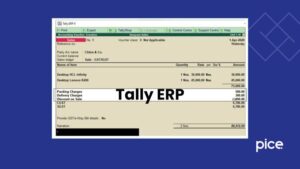What is HSN code?
- 20 Aug 24
- 13 mins

What is HSN code?
Key Takeaway
- The HSN code is a globally standardized system essential for categorizing goods for international trade, taxation, and regulatory compliance.
- Businesses must use specific HSN codes on invoices and GST filings depending on their aggregate annual turnover, with varying requirements for different turnover brackets.
- Proper use of HSN codes in GSTR-1 enhances tax calculation accuracy, simplifies compliance, and aids in efficient tax authority audits.
- The GST portal facilitates the correct application of HSN codes by providing tools and resources to help businesses find and apply the appropriate codes.
- Including HSN codes on invoices is mandatory for registered businesses above certain turnover thresholds to ensure uniformity and transparency in the GST system.
The Harmonized System of Nomenclature (HSN) code is used to classify commodities in a systematic manner, which is necessary to navigate the difficulties of international trade and taxation. The HSN code system was created by the World Customs Organization and is essential for standardizing goods for shipping, taxes, and many other purposes. HSN is widely utilised and implemented in almost 200 nations, accounting for an incredible 98 percent of the world's goods
Understanding the HSN Code and Its Full Form

The HSN code, or Harmonized System of Nomenclature code, provides a systematic classification for goods all around the world. This 6-digit HSN Code is used internationally to classify products and facilitate seamless communication between different tax authorities. By using a detailed classification, the code helps in identifying products during shipments and in calculating the GST Rates accurately.
Understanding the complete form of the HSN code is essential for companies, particularly Indian manufacturers and service providers, since it establishes the foundation for interacting with Customs and Central Excise, in addition to submitting GST returns. The first two digits of the code reflect a broad category; the next two represent a more narrow category; the final two represent the most thorough classification; together, these four numbers make up the minimum 6-digit HSN code required for international trade.
How to Decode HSN Codes
HSN codes use a string of digits, each set of which represents a distinct category of goods, to organize things into a logical and systematic classification. The normal format for HSN codes is six digits, but an eight-digit code may be used, depending on the nation and the intricacy of the product.
First two digits (Chapter): The first two digits of the code represent the chapter to which the items are assigned, within the more general framework of the 21 sections specified in the HSN manual. These chapters are wide categories that cover a variety of products; for instance, coffee, tea, maté, and spices are covered in Chapter 9.
Next two digits (Heading): Following the chapter, the next two digits specify the heading under which the goods are classified within that chapter. This heading narrows down the range of products by more detailed features or uses, providing a more detailed classification. For instance, under Chapter 09, the heading 02 refers specifically to tea.
Last two digits (Subheading): The category is further subdivided into subheadings by the last two numbers. This thorough classification indicates particular product categories and their attributes. For instance, the final '40' in the entire code 090240 designates black tea and green tea, which are not processed further.
For companies that operate locally or within certain bounds, a Minimum 4-digit HSN Code may be adequate to comply with federal tax authorities. However, a 6-Digit or even an 8-Digit HSN Code could be required when handling overseas shipments or in nations that demand more specialized tracking and tariff items.
Businesses must use the tools on the GST Portal and the HSN handbook when applying these codes to guarantee proper application. Businesses can upload descriptions of their items into the searchable database available on the GST Portal to acquire the relevant HSN code. This helps ensure that businesses comply with Central Tax rules and keep correct records for their GST Returns.
Moreover, understanding how to decode and apply these codes correctly is essential for businesses to ensure they are charged the correct GST Rates, meet regulatory requirements, and facilitate seamless communication between various stakeholders, including Customs and Central Excise.
In summary, decoding HSN codes involves understanding the breakdown from broad tariff items to specific product details, using resources like the GST Portal for accurate application, and consulting the detailed HSN manual or tax professionals to ensure compliance and correct tax rates application. This helps in managing Outward Supplies effectively and ensures that tax invoices reflect accurate and necessary information as per Indian taxation rules under the GST regime.
Benefits of Mentioning HSN Codes in GSTR-1
The GSTR-1 form, which is used to detail Outward Supplies under the GST regime, has various advantages that are essential for business efficiency and compliance when mentioning HSN codes. This form's use of HSN codes streamlines numerous facets of the taxes procedure and guarantees that companies may handle their responsibilities with greater efficiency.
First off, businesses make it easier for the tax authorities to identify and classify the items being delivered by including the 6-digit HSN Code in GSTR-1. This helps to streamline the tax assessment process. This degree of information helps the authorities apply the appropriate GST Rates for different kinds of goods, which guarantees precise tax computations. Therefore, using HSN codes helps reduce tax computation problems that can cause disagreements or inconsistencies later on.
Furthermore, the HSN code-based systematic classification improves openness and consistency in the way transactions are reported and recorded on the GST Portal. This is especially helpful for Central Tax compliance since it synchronizes local business operations with international trade norms, strengthening the accuracy and dependability of tax information filed in GST Returns.
These codes are also used by the GST Portal to automate some steps in the tax filing process, which lessens the administrative load on companies. Businesses can concentrate more on their main business operations rather than the logistics of compliance, as this automation guarantees that data entry errors are avoided. HSN codes' efficiency and clarity make it easier to verify and reconcile bills more quickly, which is helpful for audits and tax authority reviews.
The function of HSN codes in the GST E-way bill and E-invoice systems is another noteworthy benefit. For these systems to work properly, products must be accurately classified, and the HSN codes give the code data needed to track and manage products all the way through the supply chain.
In summary, using HSN codes in GSTR-1 helps the Central Tax administration manage Outward Supplies more successfully while also increasing operational effectiveness and regulatory compliance. This procedure not only satisfies legal criteria but also guarantees smooth coordination and communication with tax authorities, resulting in a more efficient GST procedure.
Why HSN Codes Are Mandatory in GSTR-1
HSN codes are mandatory in GSTR-1 for several reasons, all of which are designed to streamline the process of taxation under the GST regime and enhance the efficiency of the tax system both nationally and internationally. Here's why including these codes is crucial:

Standardization and Uniformity: HSN codes provide a standardized method of classification of goods, which is recognized globally. By using the systematic classification of HSN codes, businesses ensure uniformity in the items listed in their GSTR-1 forms. This uniformity is essential for tax authorities to efficiently process and analyze the vast amounts of data they receive. The consistent use of HSN codes across all platforms and documents simplifies the work of the tax authorities, reducing the potential for confusion and errors in tax assessment.
Facilitating Accurate Tax Calculation: The primary purpose of including HSN codes in GSTR-1 is to facilitate accurate GST calculation. Each HSN code corresponds to a specific GST rate, which varies depending on the type of product. By specifying the HSN code, businesses automatically categorize their products under the correct tax bracket, ensuring that the appropriate amount of tax is applied based on Central Tax guidelines. This accuracy is vital for maintaining compliance and avoiding penalties related to misclassification.
💡If you want to pay your GST with Credit Card, then download Pice Business Payment App. Pice is the one stop app for all paying all your business expenses.
Compliance and Audit Efficiency: From a compliance perspective, using HSN codes in GSTR-1 helps businesses and tax authorities quickly verify the details of transactions during audits. Clear categorization and the detailed classification provided by HSN codes make it easier to cross-verify reported data with actual tax dues. This level of detail supports tax authorities in pinpointing discrepancies and addressing them promptly, which is crucial for maintaining the integrity of the tax system.
Integration with International Standards: Since HSN codes are internationally recognized, their use in GSTR-1 helps integrate the Indian taxation system with global trade practices. This integration is particularly important for businesses involved in import and export activities, as it allows for seamless communication and documentation alignment across borders. The uniform system aids in fulfilling regulatory requirements globally, enhancing the ease of doing business internationally.
Enhancing Transparency and Reducing Frauds: Including HSN codes in GSTR-1 enhances transparency in the filing of GST returns by providing clear and precise product information. This transparency is crucial for both businesses and tax authorities to ensure that every taxable item is correctly accounted for. Additionally, the clarity offered by HSN codes helps in minimizing the chances of tax evasion and frauds, as each item’s tax liability is clearly defined and traceable.
How to Include HSN Codes in GSTR-1
Including HSN codes in GSTR-1, the GST return form for reporting outward supplies, is a vital process for businesses to ensure compliance with GST regulations. Here’s a step-by-step guide on how to correctly include HSN codes in GSTR-1:
Step 1: Determine the Appropriate HSN Code
Before you can include HSN codes in your GSTR-1 form, you must determine the correct HSN code for each product you sell. The HSN code is a 6-digit number that categorizes goods based on a systematic classification. Larger businesses with extensive inventories may need to use an 8-digit HSN Code for more detailed reporting. It’s crucial to use accurate and up-to-date codes to ensure compliance with tax regulations.
Step 2: Access the GST Portal
Log into the GST Portal using your registered credentials. This portal is a critical tool for all your GST-related filings and queries. It’s user-friendly and designed to guide taxpayers through their GST compliance duties efficiently.
Step 3: Navigate to GSTR-1 Form
Once logged in, navigate to the return dashboard where you can find the GSTR-1 form. This form is used to report your monthly or quarterly outward supplies. Select the appropriate tax period for which you are filing the return.
Step 4: Enter Details in the HSN-wise Summary
In the GSTR-1 form, there is a specific section for entering the HSN-wise summary of outward supplies. Here, you will input the HSN codes for the goods you have sold during the reporting period. It’s important to provide details such as the total quantity sold, total value of the goods, taxable value, and the GST rate applicable.
Step 5: Review the Information for Accuracy
After entering all the necessary HSN codes and corresponding details, review the information to ensure accuracy. Errors in the HSN code or the associated tax details can lead to discrepancies in tax calculations and potential issues during audits.
Step 6: Submit the GSTR-1 Form
Once you have verified that all information is correct, submit the GSTR-1 form. The GST Portal facilitates seamless communication between businesses and the tax authorities, ensuring that all data is transmitted securely and efficiently.
Who Is Required to Use the HSN Code?
The Harmonized System of Nomenclature (HSN) code is required for businesses involved in the production, trade, or import/export of goods. Under the GST regime in India, the use of HSN codes is mandated for all taxpayers who are registered under GST. The requirement to use HSN codes provides a systematic classification of goods, which helps in simplifying the levy of taxes on the sale or consumption of goods.
HSN code limit under GST

For businesses, the requirements to use HSN codes depend on their aggregate annual turnover:
- Businesses with an aggregate turnover less than Rs. 1.5 crores are not required to mention the HSN code in their invoices or in their GSTR-1 tax returns.
- Businesses with an aggregate turnover between Rs. 1.5 crores and Rs. 5 crores must use a simplified 2-digit HSN code for both reporting in GSTR-1 and on their tax invoices.
- Businesses with an aggregate turnover exceeding Rs. 5 crores are required to use a detailed 4-digit HSN code on all their invoices and in GST filings.
Therefore, while smaller businesses may be exempt from the detailed requirements of the HSN system, they may still need to use a simplified version depending on their turnover.
Is the HSN Required on Invoices?
Yes, the inclusion of the HSN code on invoices is mandatory for registered businesses that meet the specified turnover thresholds. The details are as follows:
- For businesses with a turnover of more than Rs. 5 crores, a 4-digit HSN code is mandatory on all invoices.
- For businesses with turnover between Rs. 1.5 crores and Rs. 5 crores, a 2-digit HSN code is required on all invoices.
- For exports and imports, an 8-digit HSN code is required to align with international standards and facilitate customs procedures.
Including the HSN code on invoices is crucial because it allows for the uniform classification of goods across the GST network, aiding in the seamless processing and analysis of commodity-related data across various platforms and checkpoints. This not only facilitates tax compliance and audits but also enhances the efficiency of business operations by ensuring that all parties in the supply chain are aligned with standard tax rates and norms.


















